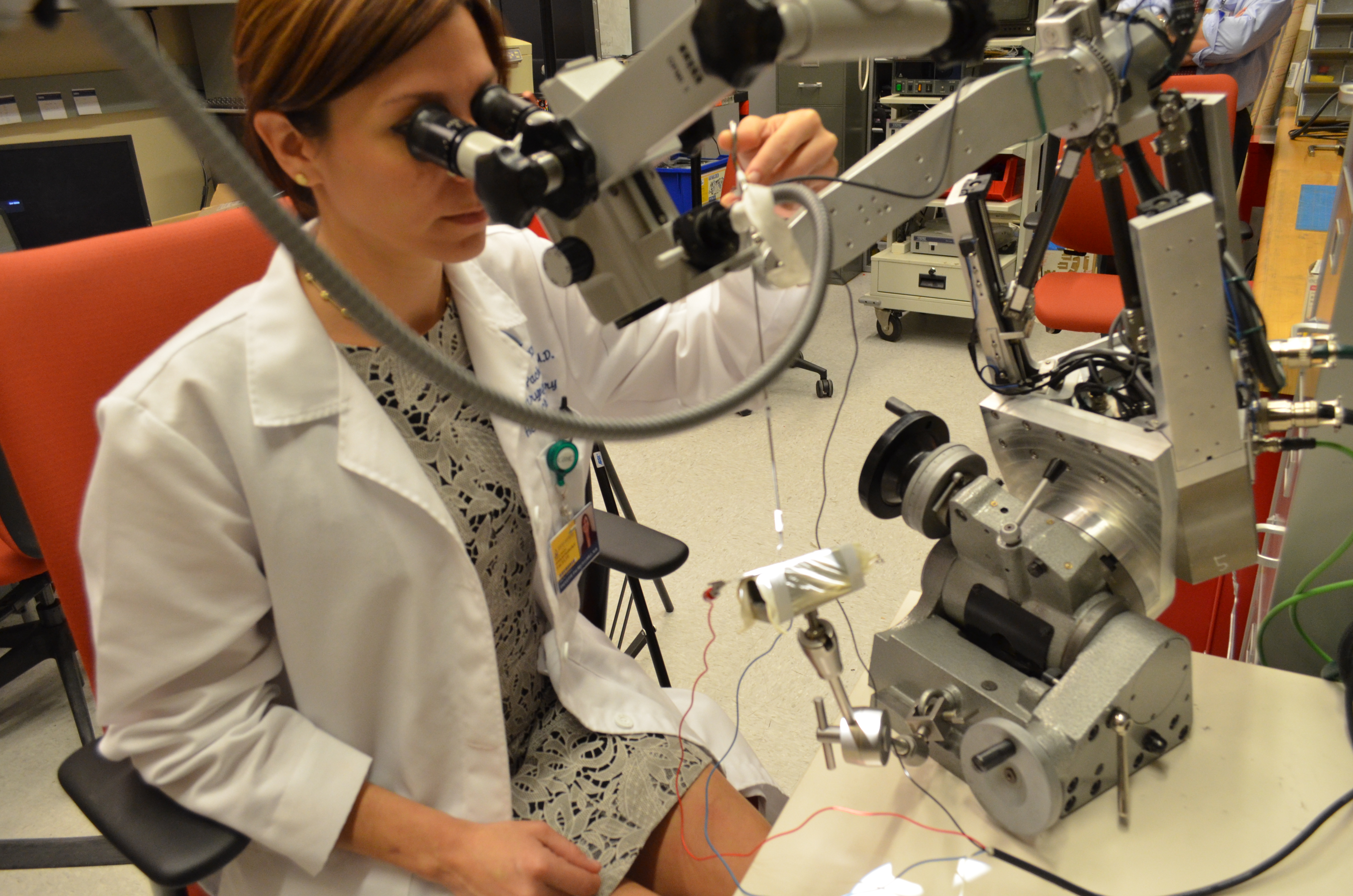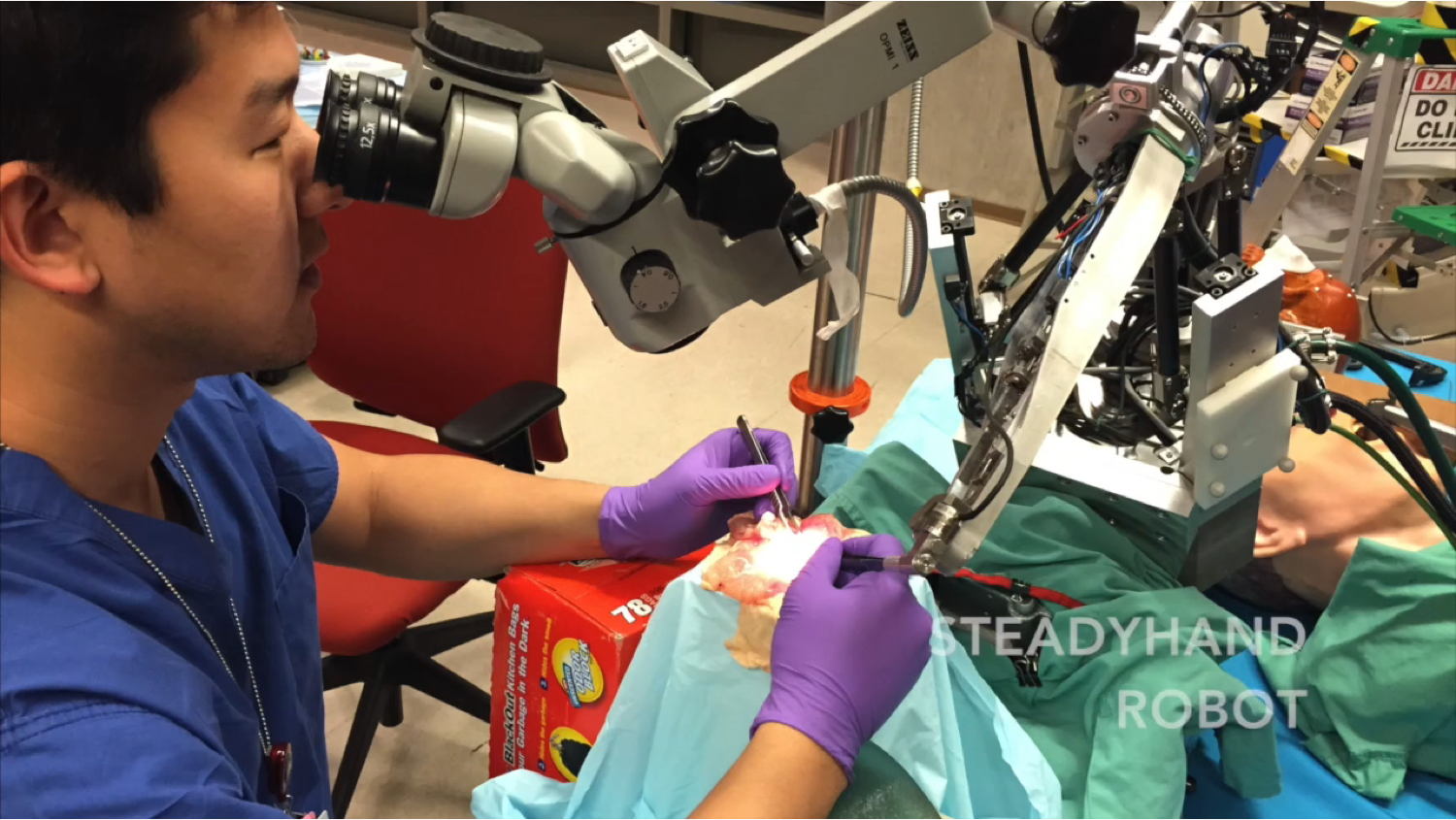Table of Contents
Robotic Ear nose and throat Microsurgery System (REMS)
There has recently been a significant movement in head and neck surgery toward minimally invasive techniques, particularly those utilizing natural orifices. However, while these techniques can reduce the risk of complications encountered with classic open approaches such as scarring, infection, and damage to healthy tissue in order to access the surgical site, there remain significant challenges, including small scale anatomy, hand tremor, reduced precision from long instruments, and difficulty navigating instruments through delicate, highly constraining anatomy. Robotic systems have been proposed to overcome these challenges, but they have generally either been single purpose systems, or systems not intended for head and neck microsurgery e.g. the DaVinci. Currently, there is no system designed for general purpose head and neck microsurgery. This project seeks to meet this need with an easy to use, relatively low cost, cooperatively controlled surgical robotic system.
Project Goals
The main goal of this project is build and validate a robotic system for general purpose head and neck microsurgery. The system should be:
- easy to use and require little modification to current surgical protocols
- cooperatively controlled, eliminating the need for a costly and bulky master robot
- capable of quick tool changes
- easily draped and sterilized
- capable of working with conventional surgical instruments
- easily re-configurable for different surgery types
Approach
 Our approach is to work closely with surgeons to determine how the system can add the most value in different head and neck surgeries, translate these specifications into a prototype, then validate this prototype using experiments designed to replicate real surgical situations. Three main surgeries are currently under investigation:
Our approach is to work closely with surgeons to determine how the system can add the most value in different head and neck surgeries, translate these specifications into a prototype, then validate this prototype using experiments designed to replicate real surgical situations. Three main surgeries are currently under investigation:
Stapedotomy is performed to insert a prosthesis into the middle ear when the natural stapes bone has been compromised, leading to hearing loss. This surgery requires ablating a 3mm diameter hole in the stapes footplate using a laser (beam diameter ~400 microns) to access the oval window. However, aiming the laser is difficult since the hole must be precisely dimensioned and the laser cannot be fired into the same hole twice to avoid heating the fluid in the inner ear and causing damage.
Endoscopic sinus surgery is one of the most frequently performed head and neck procedures, whether for the treatment of sinus ailments such as sinusitis, or to access other areas like the eye and brain. One of the most difficult aspects of sinus surgery is to navigate instruments through the complex and delicate sinus anatomy without damaging surrounding tissues. The anatomy of the sinuses can vary dramatically from person to person, making it difficult to orient instruments and track where instrument shafts will contact surrounding tissue.
Microlaryngeal Phonosurgery (MP) is a prime example of tremor and limited precision due to long instruments. In MP, pathologies must be removed from the vocal cords while preserving as much of the thin vibratory tissue layer as possible, since this layer has a significant effect on voice outcomes. Surgical instruments are typically 23cm long from handle to tip, greatly amplifying hand tremor and decreasing precision, while the vibratory tissue layer is less than a millimeter thick.
We are also currently investigating microvascular surgery as a possible application.
Status and Results to Date
We have constructed a prototype manipulator and have performed a number of evaluation experiments on phantoms and cadavers. These include:
- Basic dexterity assessment and assessment of stable-hand manipulation of long instruments in a micro-laryngeal phantom.
- A cadaver study of micro-laryngeal surgery
- A cadaver study of image-guided sinus surgery
- A study of microsurgical anastomosis of 3 mm vessels on a chicken leg phantom
Work is underway on engineering enhancements of the prototype manipulator, development of an adjustable support structure, and on development of additional application testbed demonstrations.
Project Personnel
Technical Team
Current
- Russell Taylor
- Yunus Sevimli (Research Engineer)
- Paul Wilkening (Ph.D. Student)
- Lihang Feng (Visiting Ph.D. Student)
- Kevin Olds (Technical consulting)
Past
- Kevin Olds (Ph.D. & Postdoc)
- Marcin Balicki (Postdoc)
- Preetham Chalasani (MS Student)
Advisors:
- Jeremy Richmon MD
- Lee Akst MD
- Masaru Ishii MD
- Wade Chien MD
- Matt Stewart MD
- Henry Brem MD
- Russell Taylor
- Iulian Iordachita
- Kevin Olds
CIS 2 Course Projects
- Surgical Instruments for Robotic Microsurgery (2015, Zaid Ashai, Pranav Lakshminarayanan)
- The Robotic Ear Nose and Throat Microsurgery System (REMS): Calibration and IRB Study (2015, Brian Gu, Barbara Kim, Kurt Lee)
Funding
- Project is supported by JHU internal funds
Publications
- K. Olds, Robotic Assistant Systems for Otolaryngology-Head and Neck Surgery, PhD thesis in Biomedical Engineering, Johns Hopkins University, Baltimore, March 2015.
- K. C. Olds, “Global Indices for Kinematic and Force Transmission Performance in Parallel Robots”, IEEE Transactions on Robotics, vol. 31- 2, pp. 494-500, April, 2015.
- K. Olds, P. Chalasani, P. Lopez, I. Iordachita, L. Akst, R. H. Taylor, “Preliminary Evaluation of a New Microsurgical Robotic System for Head and Neck Surgery” IEEE International Conference on Robotics and Automation (ICRA) 2014.
- C. He, K. Olds, I. Iordachita, R. H. Taylor, “A New ENT Microsurgery Robot: Error Analysis and Implementation” IEEE International Conference on Robotics and Automation (ICRA) May 2013.
- C. He, K. Olds, L. M. Akst, W. W. Chien, M. Ishii, I. Iordachita, and R. H. Taylor, “Evaluation, Optimization, and Verification of the Wrist Mechanism of a New Cooperatively Controlled Bimanual ENT Microsurgery Robot,” In Proceedings of ASME International Mechanical Engineering Congress & Exposition, IMECE2012, Houston, Texas, USA, Nov. 2012.
- K. Olds, A. Hilel, E. Cha, M. Curry, L. Akst, J. Richmon, and R. Taylor, “A Robotic Assistant for Trans-Oral Surgery: The Robotic Endo-Laryngeal Flexible (Robo-ELF) Scope ”, in Hamlyn Symposium on Medical Robotics, London, June 19-20, 2011. pp. 75-77.


